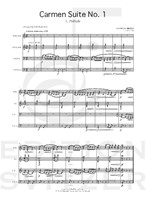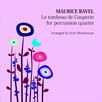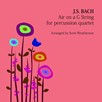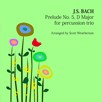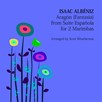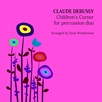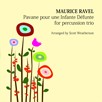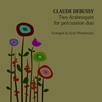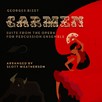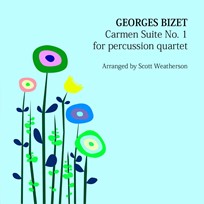
Carmen Suite No. 1
Composer: Georges Bizet
Instrument: Percussion Quartet
Level: Intermediate
Published: 2014
Price: €45.00
Item details
-
Description +
-
Arranged by Scott Weatherson
Duration: 13 min.
The melodies from Carmen by Georges Bizet are some of the most well known in the world. The Suite No. 1 from the opera (compiled after the composers death by Ernest Guiraud) contains many of these instantly recognisable tunes. In this arrangement for xylophone, vibraphone and 2 marimbas, the colours of the orchestra translate perfectly to keyboard percussion with the timbres of each instrument well suited to the exotic flavours of the opera. The vibraphone and marimba parts each require 3 and 4 mallet technique in various movements and the 2nd marimba part is written for a 5 octave instrument.
-
-
Instrumentation +
-
Percussion Quartet (4 players)
Required Instruments:
1 Xylophone
2 Vibraphones
2 Marimba (including one 5 octave instrument)
-
-
Watch+
-
About the composer +
-
Georges Bizet (25 October 1838 – 3 June 1875), registered at birth as Alexandre César Léopold Bizet, was a French composer of the romantic era. Best known for his operas in a career cut short by his early death, Bizet achieved few successes before his final work, Carmen, which has become one of the most popular and frequently performed works in the entire opera repertoire.
During a brilliant student career at the Conservatoire de Paris, Bizet won many prizes, including the prestigious Prix de Rome in 1857. He was recognised as an outstanding pianist, though he chose not to capitalise on this skill and rarely performed in public. Returning to Paris after almost three years in Italy, he found that the main Parisian opera theatres preferred the established classical repertoire to the works of newcomers. His keyboard and orchestral compositions were likewise largely ignored; as a result, his career stalled, and he earned his living mainly by arranging and transcribing the music of others. Restless for success, he began many theatrical projects during the 1860s, most of which were abandoned. Neither of his two operas that reached the stage in this time—Les pêcheurs de perles and La jolie fille de Perth—were immediately successful.
After the Franco-Prussian War of 1870–71, during which Bizet served in the National Guard, he had little success with his one-act opera Djamileh, though an orchestral suite derived from his incidental music to Alphonse Daudet's play L'Arlésienne was instantly popular. The production of Bizet's final opera, Carmen, was delayed because of fears that its themes of betrayal and murder would offend audiences. After its premiere on 3 March 1875, Bizet was convinced that the work was a failure; he died of a heart attack three months later, unaware that it would prove a spectacular and enduring success.
Bizet's marriage to Geneviève Halévy was intermittently happy and produced one son. After his death, his work, apart from Carmen, was generally neglected. Manuscripts were given away or lost, and published versions of his works were frequently revised and adapted by other hands. He founded no school and had no obvious disciples or successors. After years of neglect, his works began to be performed more frequently in the 20th century. Later commentators have acclaimed him as a composer of brilliance and originality whose premature death was a significant loss to French musical theatre.
-
-
Reviews +
-
Review (Percussive Notes, July 2016)
Scott Weatherson has taken the memorable melodies from Bizet’s “Carmen Suite No. 1” and distilled them down to mallet-quartet form. As he states, “In this arrangement…the colours of the orchestra translate perfectly to keyboard percussion with the timbres of each instrument well suited to the exotic flavours of the opera.”
Overall, Weatherson’s arrangement is successful in trimming the full orchestra material down to its most important elements. He also does a good job of varying the orchestration within the mallet quartet in order to reflect changes in the full orchestra setting. One will need to be careful of mallet selection when programing this, especially in the xylophone, to achieve the best blend between all the instruments. The only slight disappointment about this arrangement is that none of the original percussion textures are represented, but this is understandable in trying to condense the original to mallet instruments alone.
Technique-wise there is nothing terribly difficult in this arrangement. The vibraphone and marimba players are required to have a decent grasp of four-mallet technique, but this is more to facilitate three- and four-note chords as opposed to any sort of advanced technique typically found in today’s solo keyboard repertoire. Otherwise, the biggest challenge will come from making the longer melodic lines sound as smooth and connected as possible.
I can see this arrangement working well in a smaller university setting, especially one where the music department does not have an orchestra, as this would be an excellent way to help expose students to this repertoire. With the minimum amount of equipment required, this arrangement is easily approachable for a wide range of ensembles, from high schools looking for something for a festival performance to professional quartets looking to bring Bizet’s familiar melodies to a program.
—Brian Nozny
-
-
Credits +
-
Front Cover Graphics and Layout: Ronni Kot Wenzell
Engraving: Scott Weatherson & CPH Engraving
Printed in Copenhagen, Denmark
Copyright © Edition Svitzer
www.editionsvitzer.com
-
